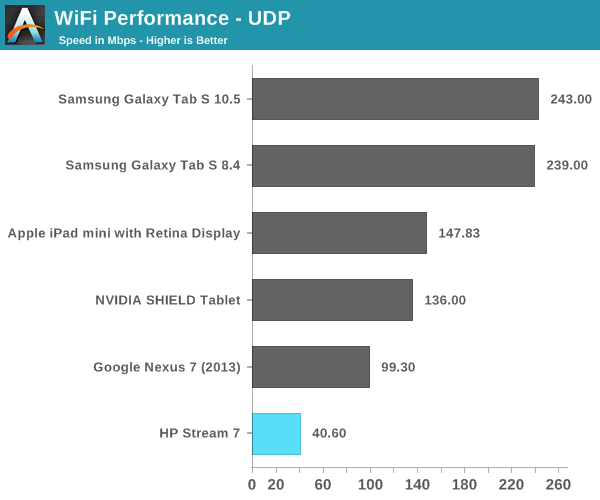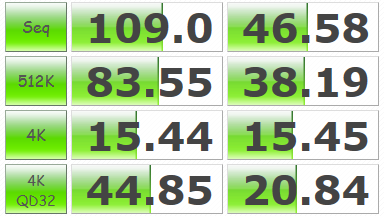HP Stream 7 Review: A $119 Windows Tablet
by Brandon Chester on December 19, 2014 8:00 AM ESTCamera
It looks like including a camera is now a requirement for pretty much any device, and so even the Stream 7 has a front-facing and a rear-facing camera. In the Windows device manager, the front camera identifies itself as "Camera Sensor GC310". I haven't been able to find any information about it, but the image quality leads me to believe that it may be best for people to not know where it came from. The rear camera idenitifes itself as HM2056, which I was able to find information about. It's made by a company called Himax Imaging, and if you haven't heard of them it's okay, because I hadn't either. It's a 2MP 1/5" sensor, which translates to 1.75 micron pixels. It has no auto focus, and that combined with the specifications leads me to believe that this is normally intended to be a front-facing sensor.
As you can see, the output is really bad. The text on the back of the books is illegible, most detail is lost, and there's noise everywhere. It's just honestly not a good camera, and it's something I would only use as a last resort. It's somewhat annoying that HP felt the need to even put a rear camera on the Stream 7, as it adds to the BOM and the money could have been better used on something like a larger battery.
NAND
I mentioned earlier that the Stream 7 doesn't even have enough storage to fit PCMark 8 and some of the other benchmarks we use. Out of the box, you get around 18.5GB free. This means that we can't run our typical Windows storage benchmarks, so I've used CrystalDiskMark to get an idea of how the storage performs.
I wouldn't try making direct comparisons between this and our storage benchmarks on Android and iOS, but it's still able to give you an idea of what you can expect. The Stream 7 uses Samsung's MGB4GC eMMC solution, so we can't expect the same storage performance that you get from Windows devices with a full blown SSD. The read and write performance ends up being pretty good for an eMMC solution, although I'm suspicious of the 4k random write result considering how even the best eMMC solutions we've seen in Android and iOS tablets top out around 3MB/s.
WiFi
The HP Stream 7 uses a Realtek RTL8723BS solution for WiFi and Bluetooth. This is a single spatial stream 802.11n part, with no 5GHz support and only 20MHz channel width. That means that we're dealing with a theoretical maximum speed of 72Mbps. In real world use, it's quite a bit less, as you can see below.

Again, at $119 this is expected and can be excused. Faster WiFi would be nicer, but it's not free. My only complaint about this speed in the real world is that the slow WiFi makes it difficult to move large files over the network onto the Stream 7. This wouldn't be an issue if these Windows tablets allowed you to directly move files to them from another computer over USB, but they don't. I've also encountered issues with the WiFi disconnecting intermittently, which is incredibly frustrating when it means you have to begin transferring a large video from the beginning. I've contacted HP about this to see if they're aware of this issue, as I've seen complaints about it from other users, but I haven't received a response.
Misc
I am unfortunately not equipped to do objective audio testing on the Stream 7. It uses Realtek's audio codec, and so it isn't likely to be anything exceptional. The bottom mono speaker is adequate; there's not much to be said about it. Unfortunately, everything comes crashing down when you try to use the 3.5mm jack. Even if the Stream 7 had the best audio solution in the world, it would be crippled by this defect that I cannot believe made it to production.
Essentially, the 3.5mm jack has a great deal of noise and static, and it makes it effectively unusable. I have confirmed this with two other owners, and there are complaints about it on the web. It's likely that there's an insufficient amount of shielding for the audio port and PCB connections, and it's extremely disappointing. With its support for all the great video players on Windows, the Stream 7 could have been an inexpensive and powerful video player. But unless you're going to use the built-in speaker or Bluetooth headphones/speakers, there's no way to listen to audio on this tablet. When I reached out to HP about the WiFi connection issues I also asked about this, but again I haven't received a response.


















157 Comments
View All Comments
lazymangaka - Sunday, December 21, 2014 - link
I wonder if the headphone static is a problem with the Bay Trail chips or something weird with this zero cost version of Windows, because my Acer Iconia W4-820 also suffers from an annoyingly large amount of static over its 3.5mm headphone jack.Regular Reader - Monday, December 22, 2014 - link
Interesting. I have an Iconia W4 and haven't noticed the static. Does it happen to you at any volume level?AllanMoore - Monday, December 22, 2014 - link
If you live close to a MicroCenter, a much better pick would be the Winbook TW800 ($ 100). It's got a full USB 3.0, hdmi, micro sd, ips. In my opinion, it's by far the best $ 100 out there. Otherwise i would add extra $49 and buy <a href="http://www.amazon.com/gp/product/B009X3UW2G?ie=UTF... Asus Nexus 7</a>. It's faster and better value!ados_cz - Monday, December 22, 2014 - link
Whether it is a better value depends on user, I prefer the full windows 8.1 on my Linx 7, bookmark bar in IE synchronizes with my desktop pc as well as bunch of other things. It is just nice to have a proper PC in pocketable form factor. I have even found a very nice touch screen touchpad in windows store for mouse cursor navigation, handy when you connect external screen and extend the desktop. I just really love this cheap windows tablet. Linx 7 is sooo nice, 280g of full PC experience goodness :-) I have even sold my very good touchscreen Dell e5440 because it became obsolete to me, still keeping hi end mini itx desktop.harrynsally - Monday, December 22, 2014 - link
With HDMI and full size USB, I thought of getting one of these to use with external monitor and wireless keyboard/mouse.At $100, the TW800 WinBook only has 1GB RAM and 16GB eMCC storage. Even after tuning, Win 8.1 will use 95% of the storage and adding microSD only good for saving photos, documents.
For $200, you can get the TW100 WinBook that comes with 2GB RAM and 32GB eMCC storage, which will allow room to run additional software.
Did my homework and just purchased a Dell Inspiration NoteBook for $300. that included a Haswell i3 processor, 15.6" touch screen, 4GB RAM, 500GB storage, HDMI, 3 USB ports including one 3.0), optical DVD drive, 4 cell battery etc.
marvdmartian - Monday, December 22, 2014 - link
Bought one of these on BF, on sale from Office Depot for $79. Tried it for a few weeks, and I'm shipping it back to them today.Frankly, I was underwhelmed with it. As pointed out in the review, battery life is dismal.....even when it's on standby! While I wasn't using it every day, I did try to pick it up whenever possible, to attempt to immerse myself in the Windows 8 experience, as this was my first W8 device. But it seemed as though every time I picked it up to use it, I had to plug it in and charge it first! Sorry, but sitting there, doing NOTHING for 3 days, and the battery dies (from WHAT??) is NOT acceptable to me.
As I already said, this was my first W8 device.....and will likely be my last one, too. I know, I know, some people are enamored with it, and think it's the greatest thing since sliced bread. But I'm just not impressed with it (and this is the improved Windows 8?? yikes!). I have used pretty much every version of Windows since 95, and found this one to be the least intuitive one of all. Hopefully Windows 10 will bring back some of the simplicity of the older versions!
As I said, this is being shipped back today. I did a refresh of the operating system (to wipe my info off of it), boxed it up, and Office Depot is paying the return shipping. In its place, I'm looking at the year old Asus 7" tablets, running Android. I've owned one of the newer 10" tablets made by them for almost a year now, and have been much more impressed with their products, as well as their value, than any other manufacturer out there.
kg4icg - Monday, December 22, 2014 - link
I actually have this tablet, been using it for a couple of weeks now. Not bad at all,, Have a 64gb Samsung SXDC UHS-1 card in it. Actually use it to program radios in the field by way of USB-OTG adapter. Use my phone as a hotspot whenever I need to do something online. Not bad for something I picked up from Microsoft for $100. Oh by the way, I'm posting this comment thru it.kg4icg - Monday, December 22, 2014 - link
By the way, only the Back cover is plastic, the frame is metal, possibly aluminum. A Plastic tablet this size is half the weight, Namely the Samsung Tab 4.BuddyRich - Monday, December 22, 2014 - link
I recently bought a DVP8 on-sale (wanted more RAM) but considered the Stream 7.I justified it as a Raspberry Pi with a built-in screen. I mean outfitted with a case you are spending $35 to 45 for that Pi Whats another $50-60 for a multi-touch screen if you have a use for it? If you don't, obviously don't spend on it. I bought it to be a replacement for a squeezebox touch, which this does superbly.
It comes with a Windows License which is handy, you can still get Linux on it if you want the lighter-weight OS... I think the UX is rough using desktop Windows with touch. They really should have put the keyboard on the charms bar rather than taskbar as you'll be using it alot if you don't use a bluetooth keyboard.
My only complaint is the OS is not a "pro" license so I had to use Team Viewer rather RDP to connect to my device.
Wolfpup - Tuesday, December 23, 2014 - link
So glad you guys reviewed this! Very disappointing that the headphone jack is bad. Everything else seems...well, not bad or even good for a $100 tablet, but not being able to use this for media, when otherwise it would be AWESOME for media since it's real Windows kind of kills it for me.Meanwhile I think it was Toshiba has a cheap 7" one too but it's killed by using a 1024x800 (?) screen with a higher resolution scaled down to it. Seems like it both cases spending the extra $60 or whatever for the 8" tablets would be the way to go (assuming the 8" models don't have these problems).
Worth noting that actually the Windows desktop is VERY useable on a 10.6" screen...it even works pretty well through my iPad's 9.7" screen with remote desktop. (The issues there are more just that there's a bit of lag/weirdness since it's sending touch commands across a wifi network!)